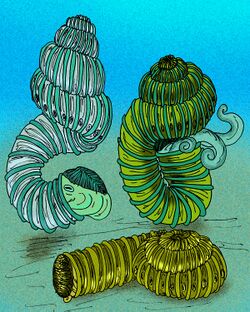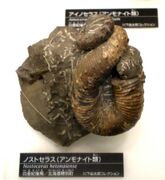Biology:Nostoceras
| Nostoceras | |
|---|---|

| |
| Scientific classification | |
| Domain: | Eukaryota |
| Kingdom: | Animalia |
| Phylum: | Mollusca |
| Class: | Cephalopoda |
| Subclass: | †Ammonoidea |
| Order: | †Ammonitida |
| Suborder: | †Ancyloceratina |
| Family: | †Nostoceratidae |
| Genus: | †Nostoceras Hyatt, 1894 |
| Species | |
|
List
| |
Nostoceras is an extinct genus of ammonites. The etymology of the name Nostoceras comes from "nostos" meaning return and "ceros" meaning horn,[citation needed] named as such by Alpheus Hyatt because it bends back on itself.
Taxonomy
Nostoceras is the type genus for the ammonite family Nostoceratidae which is included in the Turrilitoidea.[1] The Turrilitoidea, with Nostoceras and the Nostoceratidae, are commonly included in the suborder Ancyloceratina but may instead belong in the Turrilitina, a proposed order of heteromorphs thought to have a separate derivation, though this separation does not have wide support.
Fossil record
Fossils of Nostoceras are found in marine strata from the Campanian stage of the Upper Cretaceous, in the USA, Mexico, Europe (England , the Netherlands, Austria, Belgium, Denmark , France , Germany , Spain , Italy), Tajikistan, Turkmenistan, Uzbekistan, Iraq, Oman, Africa (South Africa , Angola, Nigeria)), Madagascar , Australia and Japan .[2]
Description
Nostoceras is typified by a tightly coiled helical spire on a large U-shaped body chamber with the aperture, in mature individuals, nearly touching and lying underneath the spire.[1] The initial helical whorls are covered with fine ribs and may have small spines. The U-shaped body chamber has coarser ribbing and large tubercles. Periodic constrictions may be present on the phragmocone. Species may coil either to the left or to the right. Nostoceras is like Bostrychoceras in general form, except that its ribs may be flared and the constrictions may or may not be present.
Nostoceras hyatti could reach 90 mm in length.[1]
Fossils of Nostoceras malagasyense from Campanian of Tulear (Madagascar)
Sources
- Notes
- ↑ 1.0 1.1 1.2 1.3 H. Summesberger, M. Machalski, M. Wagreich (2007). "First record of the Late Campanian heteromorph ammonite Nostoceras hyatti from the Alpine Cretaceous (Grünbach, Gosau Group, Lower Austria)". Acta Geologica Polonica 57 (4): 443-451. https://www.researchgate.net/publication/238717166.
- ↑ Cite error: Invalid
<ref>tag; no text was provided for refs namedfossilworks
- Bibliography
- Arkell et al., 1957. Mesozoic Ammonoidea, Treatise on Invertebrate Paleontology, Part L. Geol Soc. of Amer. and Univ. Kans. press.
- Larson, Neal L. 2012. The Late Campanian (Upper Cretaceous) Cephalopod Fauna of the Coon Creek Formation at the Type Locality. The Journal of Paleontological Sciences: JPS.H.2012.01. [1]
- A Pictorial Guide to Fossils by Gerard Ramon Case
Wikidata ☰ Q7061968 entry
 |



